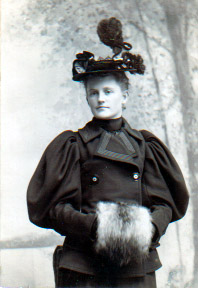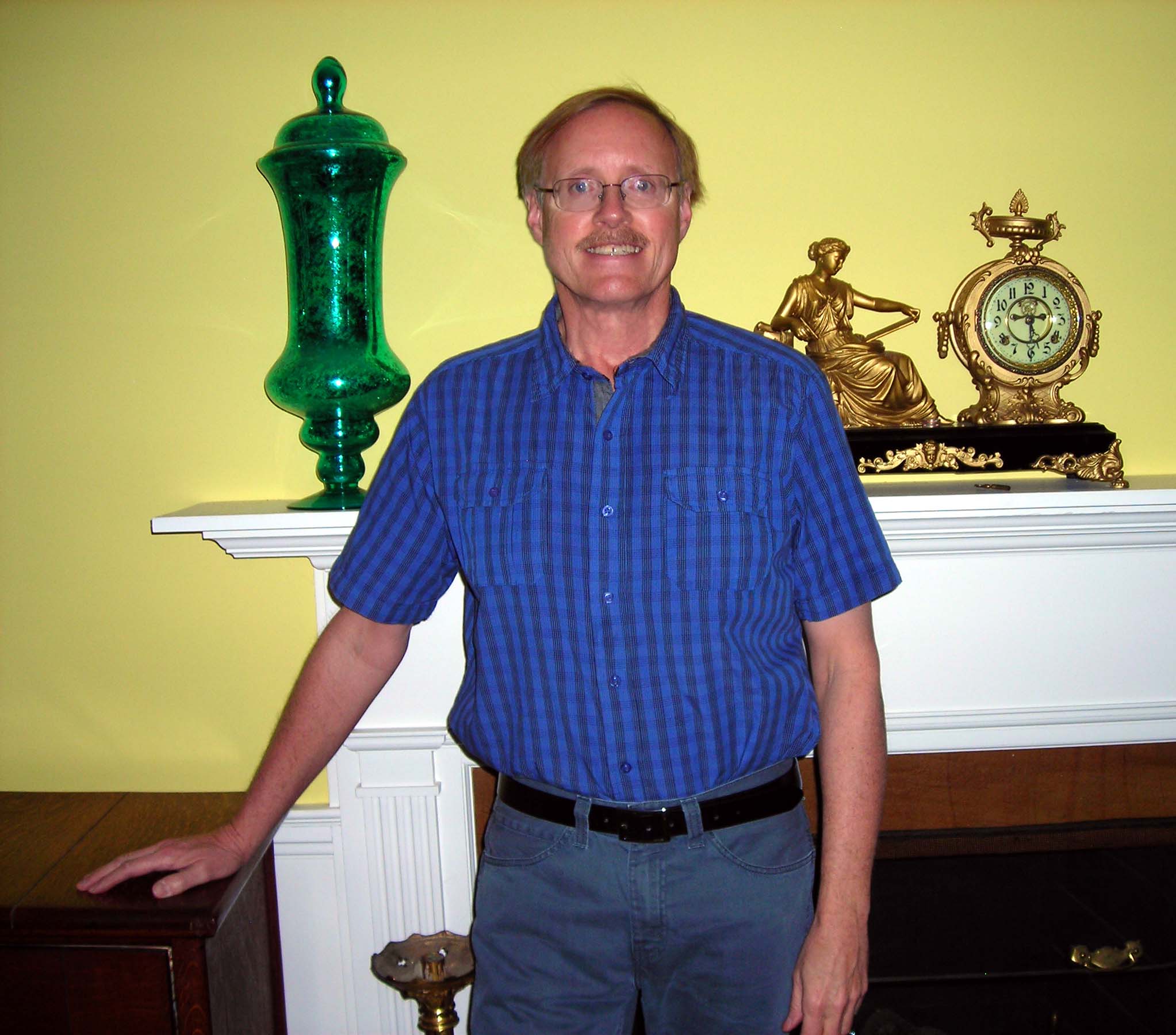 |
About the History of the Rhode Family |
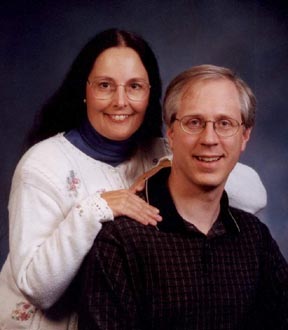 |
photo of Robert T. Rhode |
photo of Ann Miller Carr and husband, Dave |
 |
About the History of the Rhode Family |
 |
photo of Robert T. Rhode |
photo of Ann Miller Carr and husband, Dave |
From the desk of Dr. Robert T. Rhode: When Ellis G. Rhode typed his history of the Rhode family in 1959, he could not have dreamed that it would one day become available to anyone having access to a computer. His accomplishment, however, was far more miraculous than mine. He spent years compiling extensive lists of names and dates. (See a photograph of Ellis and Fern Rhode below.) All I did was scan Ellis's chronicles, edit them, add a few details, and upload them to the Internet. Ann Miller Carr and I independently of one another had been working on Ellis's history in preparation for posting it to the Internet. Ann has offered so much assistance that she has become a co-author of the Rhode Family Website.
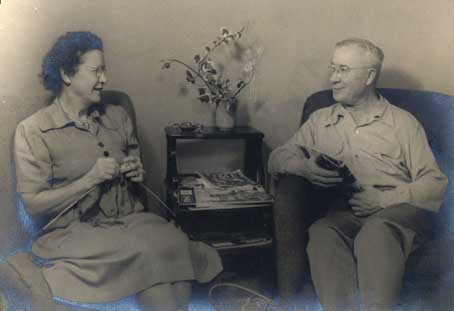
Ann and I hope that descendants of the families named in this history will find their ancestors and will help us to update and correct the information in Ellis's typescript. As meticulous as Ellis was, he made a few errors. In turn, when I scanned his document, I lost not only spacing but also dates, numbers, and portions of words. I tried to restore all of the information correctly, but I would be dreaming to think that I made no mistakes.
Ann and I have made every attempt to follow the genealogists' rule of thumb to omit information on anyone born in the past eighty years. If you find information on this website that you want removed, be sure to contact me at robert.t.rhode@gmail.com at your earliest convenience.
If you can prove to Ann's satisfaction and mine that you are a legitimate genealogist working on the history of any of the families mentioned on this website, then we may share additional information with you. Contact me at robert.t.rhode@gmail.com. Also, see my website at roberttrhode.org. I cannot always respond to email as rapidly as I would like, but I will make a concerted effort to reply in a timely fashion, especially to those messages that offer updates to Ellis's remarkable history. In turn, Ann and I may recommend that you obtain the newest version of Ann’s database, which she continually revises.
We refer to St. George's Parish, South Carolina, as being in Dorchester County, but we recognize that Dorchester was formed from Berkeley County in 1898, Berkeley from Colleton County in 1882, and Colleton from Charleston County in 1798.
We at The Rhode Family History Website were saddened to hear that our cousin and friend of the site (Sarah) Louise Rhode, 101, passed away on 05 May 2014. Louise, the elder sister of our Rhode family history “guru” Elsie Jane Rhode Smith, shared her sister’s dedication to genealogy and was a longtime member and officer of the Warren County Historical Society. For many years, she took an active part in the Farm Bureau and the Warren County 4-H Fair. She loved gardening and literature. She will be keenly missed.
The Rhode Family History site thanks these contributors for their valuable help and invites other descendants of John Rhode and directly related lines to share information:
Ellis G. Rhode for his book, John Rhode and His Descendants, on which this website is based, and his family, especially his granddaughter Karen Montfort, for endorsing this site.
Elsie Jane Smith (Mrs. Carl) and her sister Louise Rhode of Warren County, Indiana, for their marvelous research.
Other Rhode-Gray-Cobb family historians, such as Martha Kate Rhode Heath Huff.
Don Babcock for his work on John Rhode, William Rhode, and Sarah Murray.
Musette Butler, Albert Frederick “Fritz” Collier, Beverly Rhode Graves, Rhoda Simmons Watson, David Charles Rhode, Shirley Jean Hagenbugh Lowe, Joy Jepson, Shelly Leigh Bosher, John W. “Jack” Camenga, David Rhode, Raymond Reaburn and Dr. Peter Reaburn of Australia, Kathy Smuz, Scott McGlothlin, Karla Mork, Amanda Pokrzywa, Judy Eads, Jane Kosub, Peggy Dick, Deb Kuehne, and Helen Rehm.
Jeff Cheney for information on the Alaskan branch of the Rhode line.
Randy Easterling for information on the Oesterling, or Easterling, family.
Ron Eberly for his work on the Eberly family in Warren County, Indiana.
Betty Atkinson Harris Fletcher, Janet Maguire, Lou Samms, Bruce Griffis, and Robert Strickland (Cobb DNA project), who sent Cobb contributions and corrections.
Hal Hatcher and Mark Kellam, who sent detailed information on the descendants of Joseph and Elizabeth Gray Rhode, as well as other families in and near Fremont County, Iowa.
Thomas Hilk, who recently sent his entire file on the descendants of Andrew Deaver, or Dever, and Mary Mariah Deaver Cathey, who was the daughter of Arabella Gray Deaver Harrington.
Kenny Hughes, who is sending his research into the Lewis and Hughes lines.
Gerald Hurley, Margaret Miller Smith (Mrs. Hobart), and Peggy Dick, who helped with the Zadock Hurley line.
Dr. Kenneth and Mary L. Wilmeth Lowder for information on the Thomas and Mary Ballard Rhode line.
Howard McCord for his information on Martha Frances Rhode, Hannah Rhode, and descendants of Caleb Rhode.
David Martin and Michael Stanfield, who sent information on Ephraim Gray’s line.
Alan Oliver for information on the Rhode line in Warren County, Indiana.
Matthias Rhode of Germany, who has provided intriguing clues on the possible birthplace of John Rhode.
William Root, who sent information on the Root line.
Linda Stevens for her work on the Margaret “Maggie” Alice Rhode line and for her information on Sarah Talifero Rhode and Fay Kempton.
Hugh Lenox for his breakthrough discoveries about the Lewis line.
Rhoda Watson for verifying portraits of Jonathan and Dorothy Gray Rhode.
What's New in Rhode Family Research
Through help and inspiration from the contributors named above, we continue to make important discoveries. Ann has found a map showing land of a William Rhode adjacent to the plantation of John Rhode in Dorchester County, South Carolina. The age of the document makes it unlikely that this William is John's son. Could it be John's father?
The Rhode Family History Website made an important breakthrough in 2014. An email from Hugh Lenox revealed that newly published Quaker records confirmed something that we long suspected and believed but could never prove—that Caleb Easterling was a half-brother to Mary Lewis Rhode, Esther Lewis Cobb, and the rest of their Lewis siblings. An 1816 entry on page 26 of “Marriages, Births, and Deaths” at the White Lick Monthly Meeting in Morgan Co., Indiana, notes family records at the MM and says that Caleb was the son of “John & Mary Easterling.” As John Daniel Easterling’s first wife and mother of the rest of his children was said to be named Elizabeth, as he was known to have married Mary Hughs? Lewis (widow of William Lewis), and as he was married to her in 1779 and 1780 when Caleb was born, it is clear that Mary Hughs? Lewis Easterling was Caleb’s mother. Also, this entry confirms that Caleb’s wife, Martha Murray Easterling, was the daughter of “William and Martha Murray.” The Easterlings attended Sugar Grove Proprietary Meeting.
This entry leads us to theorize that Daniel Easterling’s 1782 document relinquishing his right to the property of William Lewis and declaring that William’s children would inherit it was prompted by the death of Mary Hughs? Lewis Rhode. Mary is known to have died between the birth of Caleb and the 1790 census. What other, more compelling, more urgent reason would there be for such a document—and why else would such a document be so necessary?
In July of 2004, we unearthed records showing that John moved to what is now Warren County, Ohio, in 1806, barely three years after Ohio became a state. The Rhodes were pioneers in Ohio long before they were pioneers again in Indiana. The Rhodes, Lewises, Cobbs, and Easterlings bought land on both sides of Cesar's Creek (the original spelling). Although the stream was dammed to form a reservoir in the early 1970s, much of the land of these related Quaker families is not under water. Many of these Friends attended monthly meeting in Waynesville, and the building wherein they met is still standing and still serving as a Quaker facility. The cemetery beside the Cesar's Creek meeting house is in a remote corner of the county but is maintained. The meeting house itself has been moved a few miles to Pioneer Village.
John Rhode bought land in Warren County, Indiana, in 1826. He sent sons ahead to clear the farm, and he moved to Indiana in 1828. He then sold his acreage in Ohio. Despite Ellis's account that John and his family made a circuitous trek from South Carolina, to Lake Erie, to Seymour in Indiana, and so on, we believe that deeds and Quaker records will verify that he traveled from South Carolina directly to Cesar's Creek and that, after twenty-two years in Warren County, Ohio, he moved to Warren County, Indiana.
I have tax receipts proving that John's sons did not sell land in Indiana before traveling to Arkansas. They retained their Hoosier farms throughout their ill-fated Arkansas experiment.
While we have much more to learn, we are delighted to have discovered this much in the past few months.
Research in the last several years has revealed tantalizing new clues on the Rhode, Lewis, Cobb, and Gray lines.
Clues to John Rhode’s Heritage in Germany and His Immigration to South Carolina
In March and April of 2008, correspondence with Matthias Rhode of Wingerode, Thuringen, Germany, revealed astounding clues that John Rhode might have emigrated from that area in Germany. Matthias notes that there are only two areas in Germany where the Rhode name is common. Oral history in the family holds that John Rhode chose his land in Warren County, Indiana, because it reminded him of Westphalia. Thuringen was formerly a part of the German kingdom of Westphalia.
The exchange of emails led to further research into the German conclave in Orangeburgh County, South Carolina, immediately north of St. George’s. In fact, St. George’s, in colonial times, was a part of the Orangeburgh District. Many families in Colleton or Dorchester County were descended from the Germans, Swiss, and Austrians who were recruited to immigrate to Orangeburgh in the mid-1700s. Such immigrants quickly anglicized themselves—including their names—to fit within a heavily English population.
Perhaps John Rhode emigrated from Wingerode and immigrated to the Orangeburgh District. If so, he likely would have been a Roman Catholic in Germany, as Wingerode was ruled by a Catholic monarch who permitted no other faiths. John Rhode might have converted to Lutheranism upon his arrival in South Carolina because that was the religion of the German conclave in Orangeburgh. He then might have become Anglican along with the rest of the colony. Finally, before or upon his marriage to Mary Lewis, a staunch Quaker, he joined that faith.
“The Little Stone Church” in South Carolina Where John Rhode and Mary Lewis Were Married
According to oral history that Ellis G. Rhode repeated, John and Mary Lewis Rhode were married “in a little stone church on a small island in the harbor of Charleston.” Quakers call their places of worship “meeting houses,” not “churches.” In October of 2002, Ann Miller Carr found no reference to “the little stone church” in Charleston’s libraries. In April of 2008, she phoned the South Carolina Historical Society in Charleston and talked to the archivist, Jane Aldrich, who explained that the Charleston Quaker meeting house was built at the end of the peninsula outside the city wall. She said that the location resembles an island. She did not know whether the meeting house was made of stone. The meeting house is the only place of worship that matches the one in the family story, for the Anglican Church, the only other place of worship in Charleston, was inside the city wall. Apparently, John and Mary Lewis Rhode did marry in the Quaker meeting house in Charleston.
Cobb DNA Research
The Cobb DNA project is one of the first genealogical DNA research projects
and has yielded important results. DNA studies have confirmed that the Cobb
lines in New England and Virginia were not related.
It is known that Semer Cobb lived for a number of years in Lawrence County, Indiana. There was a Jesse Cobb living in Greene County and Daviess County at the same time Semer was in Lawrence County. In Orange County just south of Lawrence County was a Samuel Cobb. Many of Samuel’s descendants reside there today. Within the past eighteen months, descendants of Samuel and Jesse participated in the Cobb DNA project. It is now known that Jesse belonged to the Ambrose Cobb line and that Samuel was from the Barnstable, Massachusetts, line of Henry Cobb. These lines are not related to Semer Cobb.
One of Semer Cobb’s descendants also has participated in the project. It is now known that Semer Cobb was definitely related to a David Cobb, born about 1760, allegedly in Dobbs County, North Carolina. Semer and David Cobb of Alabama are related to Wiley Howell Cobb of Pitt County, North Carolina, but the exact relationship remains unknown.
In 1792, Semer, Jesse, and Dixon Cobb join James Glisson in witnessing a deed in Martin County, North Carolina, whereby John and Sarah Cobb sell land to David Cobb. This might have been the David Cobb who removed to Madison County, Alabama. David is believed to be the son of William Cobb and Sarah Stancil of Dobbs County, North Carolina. David and his wife, Martha Bryant, named a son Stancil. In 1818, One of David Cobb’s daughters, Jerusha Stancil Cobb, married Azariah Cobb in Madison County, Alabama. Azariah’s mother’s name was Nancy. His father’s name is unknown, but Azariah’s father might have been a brother or cousin to David Cobb. Azariah, born in either North or South Carolina, and Jerusha name a son Semer. Azariah has seven siblings, according to deeds in Madison County, Alabama: Dickson, John, Eleazer, Theophilus T., Thomas, Hessey, and Lidy.
Ann Miller Carr has adjusted Semer Cobb’s ancestry to reflect this new information but has included questions about his siblings and possible parentage. Genealogists await additional results from the Cobb DNA project.
Cobbs Lane
A careful review of current maps of St. George, Dorchester County, South Carolina, and the map on Semer Cobb’s 1797 patent deed to his land in that county (then part of Colleton County) reveals that the present-day road called Cobbs Lane is indeed on Semer Cobb’s land, which was next to John Rhode’s and Caleb Hughes’ (d. 1798) land.
Lewis Heritage
Kenny Hughes sent intriguing information that could link the Lewis and Hughes lines to Pennsylvania. Kenny indicates that Caleb Hughes, the suspected father of Mary (Hughes?) Lewis Easterling, the mother of Mary Lewis Rhode and Esther Lewis Cobb, might have been the son of a David Hughes who belonged to the Chester County, Pennsylvania, MM. This Quaker meeting house was located in Merion Twp.
From Will Abstracts, Book C, 1705-1714, Philadelphia Co., PA, p. 160:
Quaker David Hughes, born about 1676, Merion Twp., Chester Co., Pennsylvania, married 4 Nov. 1696 in Merion MM, Merion Twp., Chester, PA. to Martha Lewis, daughter of Ralph and Mary Lewis. Had children:
1. David Hughes II (Jr.), b. 19
Mar. 1697, Chester Co., PA
2. Jonathan Hughes, b. 1699 Chester Co., PA
3. Samuel Hughes, b. abt. 1701 Chester Co., PA
4. Caleb Hughes, b. 1703 Chester Co., PA
5. Ruth Hughes
6. Mary Hughes
Ralph Lewis b. 1650 and emigrated
from Glamorgenshire, Wales, to Chester Co., PA, in the 1680s
Mary Lewis, wife of Ralph Lewis and mother of Martha Lewis, died in Aug. 1704,
buried at Merion MM cemetery
David Hughes, Haverford, Chester Co.
Will written 27 Apr. 1709; proven 9 Jun. 1709
Children: David, Ruth, Mary, Jonathan, Samuel, Caleb
Executrix: wife Martha
Overseers: Father-in-law Ralph Lewis,
cousins David Lewis, William Lewis and Lewis David.
Witnesses: Daniel Lawrence, Thomas James, Robert Jones, Henry Lawrence
From Will Abstracts, Book N, p. 344:
Ralph Lewis, 19 Sept. 1712 (Kenny did not send or obtain)
In 1730, Jonathan Hughes might have had a son, Caleb Hughes (but Kenny says
it could have been David, Jr., or Samuel)
From Abstracts of Dobbs Co. and Pre-1880 Lenoir, North Carolina, Indentures,
abstracted by Francis Roland Hodges, III:
Nature of document: Indenture
Date: 2 Aug. 1757
Grantor: Caleb Hughes, joiner
Grantee: Major Croom
Location: east side of fauling creek [sic]
Extent: 80 acres
In consideration of: 20 pounds proclamation money
Witnesses: John Howell, Richard Caswell
Nature of document: Deed of sale
Date: 11 Aug. 1777
Grantor: Jonathan Hughes of South Carrolina (sic)
Grantee: Major Croom of Dobbs County
Location: west side of Falling Creek
Extent: 130 acres
In consideration of: 30 pounds proclamation money
Mentioned in description of bounds: Caleb Hughes, Lovick Young
Witnesses: Francis Hill, two additional names illegible.
Further research is needed to establish ties between these families and to prove
that Mary (Hughes?) Lewis Easterling was a Hughes and that the Lewises in the
Chester County, Pennsylvania, MM are related to Thomas Lewis and his son William
Lewis, the first husband of Mary (Hughes?) Lewis Easterling and the father of
Mary Lewis Rhode and Esther Lewis Cobb. It is intriguing that Dobbs County shows
up here—especially as Semer Cobb is related to the Cobb lines there.
Lydia Frances (?) Burchfield Rose “Boggs” the Missing Gray
Infant
There is a possible relationship among three individuals who were close neighbors
in Burke County (now McDowell County), North Carolina, in the 1770s through
the 1790s:
1. Greenberry Wilson, b. 1755, d. 1812
2. Arabella (some say Averilla or Aberilla) Wilson Burchfield, b. abt. 1750
in Maryland; married Nathan Burchfield, some say in St. George's Parish, Maryland
3. Lydia (Richardson?) Gray, b. abt. 1747, wife of William Gray (1745-1780)
His wife, Lydia, administered William Gray’s estate. Greenberry Wilson
was one of the men who posted bond for her, and bondsmen were customarily relatives.
William and Lydia had a daughter named Arabella (b. abt. 1770-1773). Arabella
was not a common name. Nathan and Arabella named a daughter Lydia (b. 19 Nov.
1779). Greenberry Wilson and Arabella Wilson Burchfield are witnesses in at
least one court case in Burke County. Nathan Burchfield was the son of Robert
Burchfield (b. 27 Feb. 1709 or 1710 in St. George's Parish, Maryland [then in
Baltimore County, now in Harford County]) and Ann Clark. Robert Burchfield was
the son of Thomas Burchfield and Mary Wilson, who married on 30 Jun. 1709 in
St. George's Parish. There was a Greenberry Wilson in the tax lists and other
documents in Baltimore County, Maryland, in 1765-1773. Unless the Greenberry
Wilson in Burke County was actually born before 1744, this is another, older
Greenberry Wilson.
All three men (William Gray, Nathan Burchfield, and Greenberry Wilson) were
indicted by the Burke County court and accused of being Tories, but the charge
against William, at least, appears to have been dropped either because the charge
was false or because there was a lack of evidence. During the course of the
war, he might have switched allegiance to the colonial cause. Nathan Burchfield
was one of the witnesses against William Gray. Greenberry Wilson’s descendants
say he was a Revolutionary War veteran who fought for the colonies.
Could Lydia (Frances?) Burchfield Rose be the missing infant daughter of William
and Lydia Richardson Gray? According to Ephraim Richardson Gray and Arabella
Gray Deaver Harrington’s lines, William and Lydia Richardson Gray of Burke
County, North Carolina, had five children: John; Ephraim; William, Jr., who
appears to have died young; Arabella; and an infant daughter. (John’s
line said there were only three sons and one daughter.) According to oral history
in all three branches, William Gray left for the Battle of King’s Mountain
in the Revolutionary War. While he was gone, Lydia was accosted by Tories. The
farm was partially burned and the slaves run off. After this incident Lydia
learned that William had died in the battle, and she went into a deep depression
that lasted two or three years. The children were cared for by neighbors. After
Lydia recovered, all the children were returned to her except for one, a baby
daughter. The neighbors who had taken in the infant begged to keep her. Some
lines say the neighbors were childless or had only sons. Lydia allowed them
to keep this daughter. Although John’s branch said that this baby daughter
was Arabella, this does not appear to be the case. According to Arabella’s
descendants and her age of eighty in the 1850 census, Arabella was born years
before 1880, when the Battle of King’s Mountain occurred.
Lately, talk among Burchfield descendants online has proposed that Lydia Burchfield,
the daughter of Nathan and “Aberilla” Wilson Burchfield of Burke
County, might have been adopted. The discussion stems from Lydia’s application
for a pension through her first husband, Jacob Rose, who was killed in the War
of 1812. Lydia claimed her father was killed at the Battle of King’s Mountain
in October 1780. Allegedly, no one in the Burchfield family fits this description.
Lydia’s middle name might have been Frances. Descendants in Ephraim’s
and Arabella’s lines claim that William and Lydia Richardson’s baby
girl was named Frances, which is a name carried down in several generations
in the Gray lines.
Nathan and “Aberilla” Wilson Burchfield are documented as having
been neighbors of William and Lydia Richardson Gray. Nathan and Arabella appear
to have had three sons, but only one of them, born before 1780, lived to adulthood.
Was Lydia (Frances?) Burchfield Rose “Boggs” actually Lydia Frances
(?) (Gray) Burchfield Rose “Boggs”? Further research—and possibly
a DNA study—is needed to confirm the hypothesis that Lydia was a child
of William and Lydia Gray and adopted by Nathan and Arabella Burchfield.
Many facts of Lydia Burchfield’s life are known and can be shared with
readers who correspond with this site.
Family Members in the Civil War

Members of the extended Rhode family served on both sides of the conflict known as the Civil War (1861-65). In 2001, I acquired records from the National Archives and the South Carolina Department of Archives and History to tell the story of seven relatives who were called to duty.
Born in Center Township, Pennsylvania, Samuel Phillip McCormick, a carpenter, enlisted as a private on the 4th or 5th of September in 1861 in Company A of the Fourth Iowa Cavalry. (See Chapter Five: Samuel was married to Harriet Rhode; Joseph; Jonathan; John.) The previous August, Congress had made President Abraham Lincoln almost a military dictator. Sam responded to Lincoln's call for 500,000 volunteers by becoming a bugler for Captain Rector's horsemen. Five or six days before Sam enrolled at Sidney, Iowa, for a three-year term, he had celebrated his 29th birthday. He stood five feet six and a half inches tall and had hazel eyes, a light complexion, and dark hair. Over a year later, Sam was absent from roll call in November and December of 1862. He had fallen into the hands of the Confederates. Having been ill since early December, Sam suffered so greatly in prison that, on January 19, 1863, his captors released him to the Marine Hospital in St. Louis. On March 10, 1863, he was discharged from the Union military for "chronic diarrhoea [as the word was spelled back then] with probable ulceration of the colon and rectum, emaciation, weakness, & exhaustion." Sam returned home a physically broken man. He passed away on the 1st of September 1906.
On December 18, 1861, in St. George, South Carolina, Thomas Jefferson Murray enlisted, and, on the 7th of January, he was mustered in as a First Lieutenant in Company C of the 24th South Carolina Infantry. (See Chapter Two: Thomas Jefferson Murray; Mary; John.) A member of the South Carolina legislature, Thomas helped to form the company in which he enrolled. Thomas was only five months younger than was Sam McCormick. Records show that Thomas was paid $525 for his service from the 7th of January through the 30th of June in 1862. A legislator from the first state to secede from the Union, Thomas probably felt alarm when Union forces during 1862 managed to take enough forts to control the North Carolina coastline. In late summer, Thomas contracted typhoid fever, and, on September 6, 1862, he died.
Thomas's older brother Joseph J. Murray was a physician. (See Chapter Two: Joseph J. Murray; Mary; John.) With a fair complexion, black hair, and hazel eyes, Joseph stood five feet nine inches tall. He resided at Orangeburg, South Carolina. He joined Hatch's Regiment of Coast Rangers, known as Co. F & S of the 23rd South Carolina Infantry. Born in 1824, Joseph turned 40 years of age in the next-to-the-last year of the war. He was appointed to service in the Confederate Army on June 1, 1862. By 1863, Dr. Murray was listed among the officers of Evans's Brigade. On February 6, 1863, he was promoted from the rank of Assistant Surgeon to Surgeon. On the 1st of July of that year, Joseph requested forage for his three privately owned horses. The daily allowance for his steeds was nine pounds of corn, nine pounds of hay, nine pounds of oats, and five pounds of fodder. By the 1st of September, Joseph had managed to increase the daily allotment to twelve pounds each of corn, oats, and hay and ten pounds of fodder.
The record of Dr. Murray's requisitions provides insight into the life of a Confederate surgeon. On the 14th of November 1863, Joseph asked for a hospital tent: "There being but one on hand, and that in such a dilapidated condition as to be unfit to protect the sick." His request was received at Mount Pleasant, South Carolina. On the 19th of December in that same year, Dr. Murray requested a pair of shoes. On the 31st, Joseph, then at Sullivan's Island, called for another hospital tent. He stated, "There is only one on hand and that is not sufficient." On the 17th of May 1864, Joseph requested three quires of writing paper, saying, "The paper is needed for making out Requisitions and other necessary papers connected with the Hospital." On June 24th at Petersburg, Virginia, Joseph called for one oven and lid, one frying pan, two cast-iron pots weighing forty-one pounds, and one tea kettle. He justified these requests with the fact that " . . . the hospital connected with this Regt is without the necessary cooking utensils." On July 16th, Joseph asked for three more quires of paper: "A scanty supply being furnished through the regular channel, it not being sufficient for the use of Medical Dept." This request was received in the field. On November 11th, Joseph wanted five pounds of nails, and, on the 20th of that month, he needed an army tent, "required for the Steward and Nurses of this Regiment." On the same day, he put in a request for a mess pan and a camp kettle.
Dr. Murray invoiced acids, various kinds of sulfur, morphine, olive oil, various kinds of camphor, potassium nitrates, opiates, quinine, cupping glasses, pocket cases, teeth extracting forceps, candles, nutmegs, tea, whiskey, bed sacks, blankets, pillow ticks, cotton batting, red flannel, assorted corks, screws, ink, steel pens, writing paper, envelopes, pencils, vials, spatulas, and bottles.
On the 2nd of April in 1865, Joseph was captured. He was taken to the Old Capitol Prison in Washington, D.C. Sometime between the 11th and the 13th of May, he arrived at Johnson's Island, the Union prison located at Sandusky Bay, Ohio. On June 23rd, he took the Oath of Allegiance to the United States and was released. He lived into his mid-70s.
Caleb B. Rhode enlisted as a private in Company C of the 25th Infantry Regiment of Iowa. (See Chapter Two: Caleb B. Rhode; Thomas; John.) His unit fell under the command of the 2nd Brigade, the 1st Division, the 15th Corps. Born in 1834, Caleb was 28 years old when he was mustered into service on August 15th in 1862. Although he was born in Warren County, Indiana, his family had moved to Iowa. He enlisted in Salem for a period of three years. He was a farmer. He stood five feet nine and a half inches tall. He had dark hair and a dark complexion. His eyes were gray. While helping John A. McClernand and William Tecumseh Sherman to take Arkansas Post on January 11th, 1863, Caleb received a musket ball through his left arm at the shoulder and a shell in his right leg. He struggled to hold onto life. In February, he was sent up river to Memphis, where he was admitted to General Hospital Number Three. On February 24th (One record says it was February 23rd.) he passed away. His effects included a cap, a flannel sack coat, a pair of trousers, two pairs of flannel drawers, two cotton shirts, a pair of shoes, three pairs of socks, two blankets, and a needle case.
On the day that Caleb was mustered in, Daniel M. Fenton, from Caleb's birthplace of Warren County, Indiana, enrolled for service as a fifer in Company G of the 100th Regiment of Indiana Infantry. (See below: Daniel M. Fenton's daughter Magnolia "Nolia" Somerset married Joseph T. "Tom" Cobb; their daughter, Kosie Ruby, married Seymour Alfred Rhode.) The 32-year-old Daniel was mustered in on September 27, 1862, at Indianapolis, whereupon he was paid a $25 bounty. Daniel stood five feet six inches tall. He had a fair complexion with light hair and blue eyes. He was a farmer. At Grand Junction, Tennessee, in February of 1863, he suffered from the privations of a cold winter in the field. Fifers played music to march the armies toward battle and helped to clear the field of the wounded and dead after battle. Daniel saw more than he wanted to see of the terror of warfare, and, physically, he broke down. For the rest of his life, he complained of chronic diarrhoea and rheumatism from the exposure he suffered in Tennessee. His medical record indicates that he had jaundice and disease of the liver. Periodically throughout the years after the Civil War, he applied for pension increases, and he received a few. He came to be called "Uncle Daniel" by the townspeople of Pine Village, Indiana, and he was admired by all. He lived to be 84. His daughter (my great grandmother) named Magnolia "Nolia" Somerset Fenton was born in 1863 while her father was serving in the war.
John Simmons Murray, the oldest brother of Dr. Joseph J. Murray and Legislator Thomas Jefferson Murray, was born on the 6th of January in 1819. (See Chapter Two: John Simmons Murray; Mary; John.) On December 12, 1863, he expressed his intention to enroll. He turned 45 years of age shortly after his enlistment at Cheraw on January 1, 1864. Another record suggests that he enlisted at Green Pond on his birthday. He became a private in Company D of the 5th Regiment of the South Carolina Cavalry. On July 11, 1864, he was admitted to the C. S. A. General Hospital in Charlottesville, Virginia, for chronic diarrhoea. From August 4, 1864, he was on sick furlough for sixty days. His horse died at Lynchburg, Virginia, on September 12, 1864, shortly after John's return to duty. John passed away on the 7th of November in 1882.
Samuel Rhode of Warren County, Indiana, was a farmer only 17 years and 9 months old when he enlisted at Lafayette, Indiana, as a private in Company G of the 150th Indiana Infantry. (See Chapter Two: Samuel Rhode; Caleb; Jonathan; John.) It was the 13th of February in 1865 during the final months of the conflict. Samuel was a first cousin to Harriet Rhode, who was married to Sam McCormick. Samuel Rhode stood five feet seven and a half inches tall. Like other Rhodes, he had black hair, a dark complexion, and blue eyes. Since Samuel was under age, his father, Caleb, had to give his consent for Samuel to serve. From March 13th until May of 1865, Samuel was sick at Indianapolis. By order of the War Department on May 3rd or 4th, he was discharged. One record indicates that he was discharged on the 9th. Samuel was paid $39.09 by a money order from the War Department for clothing expenses, and he was entitled to his bounty. Samuel is buried in Quaker Cemetery between Pine Village and Attica, Indiana. Every year, a new flag is placed by his grave in honor of his service in the Civil War.
The Fenton Family of Pine Village, Indiana
I am including here a little information on the Fenton family of Pine Village, Indiana. Magnolia "Nolia" Somerset Fenton married Joseph T. "Tom" Cobb and is, therefore, mentioned in Chapter 3 of Ellis G. Rhode's history. Robert C. Metsker has been helping me to discover information on the Fentons.
Magnolia's parents were Daniel "Uncle Daniel" M. Fenton, who was born on September 7, 1830, and who died in 1914, and Emma Barker Fenton, who was born on 26 February 1835 and who died on 15 October 1913. (See photographs of Daniel and Emma Fenton below. Daniel's legs were amputed because of diabetes, not from wounds received in the Civil War.) As mentioned above, Daniel served in Company G of the 100th Indiana Volunteers during the Civil War. Emma was from Ross County, Ohio.

Daniel and Emma's five children were:
1. Charles "Charlie" Wesley Fenton, who was born in 1856 and who died in 1922. He was married to Olive Catherine Metsker, who died on October 21, 1904. A free-thinking farmer, Charlie was beloved by children. His first daughter, Ruth, was born on August 24th, 1882, and died on the Fourth of July in 1896. His daughter Lena Fenton Rhode married Claire Rhode and is mentioned in Chapter 3 of Ellis G. Rhode's history. (See a photograph of Charlie Fenton below.)

2. Thomas "Tommy" Eleazer Fenton, who was the blacksmith who invented the specially weighted shoe that kept Dan Patch from "interfering" (that is, scratching the back of his front leg with his hind hoof) and who thus transformed Patch into a champion—arguably one of the greatest racing horses of all time and the first sports celebrity. (See a photograph of Tommy Fenton below.) Tommy's child by his first wife was Myrtle "Myrtie" Fenton, who married Clarence Thurman. Tommy's three children by his second wife were:
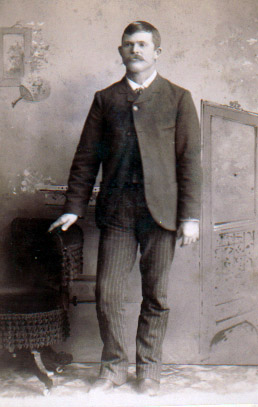
a. Samuel C. Fenton, who was born on 23 March 1877 and who died on 12 January 1921. Samuel C. Fenton was an outstanding cornetist, the first chair in Pryor's Band. He married Bessie Ogborn, daughter of Mr. And Mrs. Levi Ogborn. Samuel and Bessie's daughter was Dorothy Fenton, a pianist. (See a photograph of Samuel C. Fenton below.)
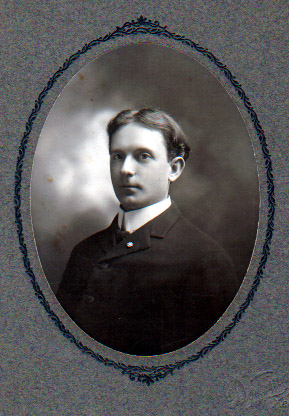
b. Pearl Fenton, who was born on 16 August 1883 and who died on 29 March 1970. Pearl married Arthur H. Clark, who was born on 20 October 1881 and who died on 9 October 1966. (See a photograph of Pearl Fenton below.)

c. Vera Fenton, who graduated from Pine Village High School in 1912.
Pete Thurman, one of Myrtie Fenton Thurman's sons, married Louise Wagner, who was a sister of Margaret Wagner, who married (1st) Charles "Charley" or "Cobbie" Albert Cobb and who married (2nd) Doc Goddard, the veterinarian. Margaret is mentioned in Chapter 3 of Ellis G. Rhode's history.
3. James "Jimmie" Fenton, whose wife's first name was Ida. (See a photograph of Jimmie and Ida with their great nephew Joseph Curtis Rhode below.)
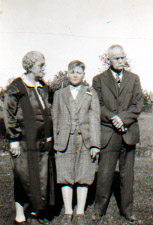
4. Magnolia "Nolia" Somerset Fenton Cobb, who was born in 1863 and who died in 1922. Magnolia was an accomplished photographer. (See a photograph of Magnolia in Chapter 3 of Ellis G. Rhode's history.)
5. Sarah "Sattie" E. Fenton, who was born in 1875 and was close in age to her niece, Kosie Ruby Cobb Rhode, daughter of Magnolia and Tom Cobb. Sattie and Kosie were fast friends. (See a photograph of Sattie Fenton below.)
